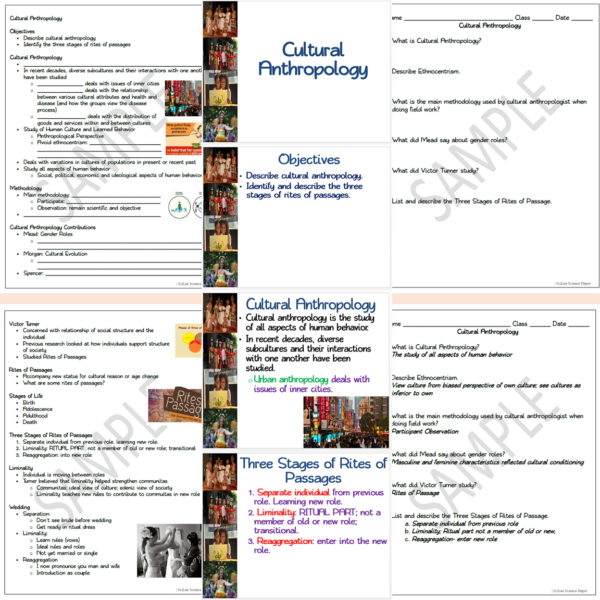In the tapestry of human existence, cultural anthropology weaves a thread of exploration, sewing together the manifold narratives that define various societies throughout history. The significance of this field is paramount in understanding human behavior, societal norms, and the intricate philosophies that set different cultures apart. A cultural anthropology worksheet serves as a foundational tool for both educators and students to delve deeper into this vibrant discipline. It catalyzes learning, enabling individuals to engage actively with the rich complexities of human diversity.
To comprehend cultural anthropology, one must appreciate its essence: a study underpinned by inquiry into the customs, rituals, and belief systems that define a people’s way of life. Each worksheet encapsulates this exploration, inviting participants to reflect on the myriad facets of culture, including language, art, religion, and social structure. The process is akin to peering through a kaleidoscope—each turn reveals new colors and patterns, symbolizing the endless possibilities inherent in human interaction.
At the core of a cultural anthropology worksheet lies a series of thought-provoking exercises. These activities are meticulously designed to inspire critical thinking and enhance analytical skills. For example, an intriguing exercise might ask students to observe a seemingly mundane ritual within their own community—perhaps a family gathering, a local festival, or even a daily commute. By encouraging learners to document the social dynamics, symbols, and meanings attached to these events, they begin to unravel the sociocultural fabric that shapes everyday life.
Another avenue of exploration might involve comparative analysis. Students could be prompted to research an aspect of their culture—such as marriage customs or culinary traditions—and juxtapose it with those of another culture. This comparison often illuminates the paradoxes and similarities between societies, fostering empathy and a deeper appreciation for the idiosyncrasies of the human experience. Through such engaging tasks, a cultural anthropology worksheet transforms passive learning into an active quest for knowledge, much like an archaeologist unearthing relics from a bygone era.
The unique appeal of cultural anthropology worksheets also resides in their capability to foster dialogue. In a world often fraught with discord and misunderstanding, these worksheets provide a platform for discourse. Group discussions can be facilitated around open-ended questions, allowing students to articulate their observations, challenge preconceived notions, and construct new understanding collectively. This collaborative approach not only enhances communication skills but also embodies the anthropological tenet of participant observation, where dialogue becomes both an inquiry and an insight.
Incorporated within many worksheets are multimedia elements that enrich the learning experience. Videos of cultural celebrations, sound bites of traditional music, and photographs of everyday life across the globe can create a more comprehensive educational experience. These materials serve as windows into other worlds—screen doors that, when opened, allow students to step into diverse realities. The sensory engagement often elicits emotional and intellectual responses, illustrating the visceral connection between culture and human identity.
As students navigate through cultural constructs, they are equipped with tools that transcend mere academic understanding. A well-designed worksheet encourages an introspective examination of one’s cultural identity, sparking questions such as: ‘What cultural influences have shaped my viewpoint?’ or ‘How does my environment affect my relationships with others?’ This self-reflection is vital; it fosters a sense of integrity in acknowledging that one’s perspectives are but a single thread in the elaborate fabric of human culture. Such awareness can lay the groundwork for future cultural sensitivity and respect.
The assessment components integrated into cultural anthropology worksheets can also provide vital feedback to both students and educators. Quizzes, reflective journaling, and project presentations allow learners to consolidate their knowledge and exhibit their understanding of complex concepts. The iterative process of feedback primes students for deeper engagement, reinforcing their cognitive growth while simultaneously instilling a sense of curiosity and wonder about the world around them.
Furthermore, the worksheets can serve as a bridge connecting academic concepts to real-world applications. For instance, students who explore themes of globalization and cultural exchange within their assignments may begin to recognize the socio-political implications inherent in contemporary conversations about identity and diaspora. This intersectionality between academia and lived experience exemplifies the power of cultural anthropology as more than an academic pursuit. It urges individuals to grapple with critical issues such as cultural appropriation, inequality, and the power dynamics within intercultural interactions.
As students progress through the nuanced content of cultural anthropology worksheets, the metaphor of the anthropologist as a cultural detective comes to life. Each exercise acts as a clue, leading them closer to understanding the intricacies of human behavior and social structure. The ultimate revelation is not merely about comprehending culture but about cultivating a sense of interconnectedness—the realization that the broader narrative of humanity is woven through shared experiences, challenges, and aspirations.
In conclusion, cultural anthropology worksheets are invaluable educational tools that engage learners in an intricate dance with culture. They invite students to explore the depths of human expression and the aesthetic and moral dimensions of our existence. From observation to reflection, dialogue to assessment, these worksheets weave together the vignettes of life’s rich narratives. Through this process, students emerge not only as scholars but as empathetic individuals, ready to embrace the diverse cultures that enrich our global society.
